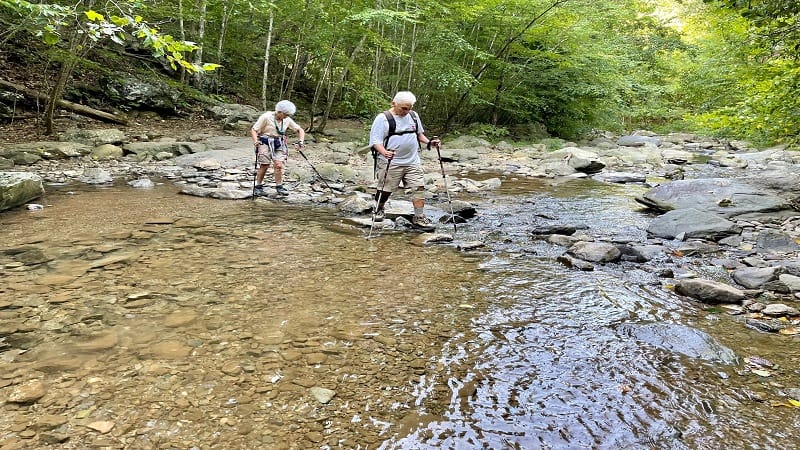Need to Know: Why Do My Fingers and Hands Swell When I Hike?
If you’re here, chances are you’ve searched for something like, “Why do my hands swell when I hike?” Don’t worry, you are not alone. This is very common.
It may feel alarming, uncomfortable or just plain annoying, but it’s not unusual for hands or fingers to swell while hiking. It typically goes away with rest, too.

Of course, knowing that it’s not uncommon doesn’t address why it’s happening, what causes hands to swell, and how to prevent swollen fingers in the first place.
Just for you, we’ve got all the answers, including how to help stop uncomfortable swelling when it happens on the hiking trails.
What Causes Swollen Hands?
There are many potential reasons why your hands and fingers may swell when you hike. Here are the main culprits when you’re out on the hiking trails.
Circulation
When you hike, your heart is hard at work pumping oxygenated blood to your major muscle groups – but not to your hands.
As a result, the blood vessels in your hands widen to allow more blood to flow through. This is harmless, but it can lead to swelling and discomfort.
Heat

When you are hiking in hot weather, your heart needs to work even harder to pump blood to your core muscle groups and regulate body temperature.
This can also cause fluid to build up in your extremities, like your hands, feet and fingers. Some even refer to this as “sausage fingers” (eek).
Constrictive Clothing or Daypack Straps
The straps of your daypack can actually lead to swelling of hands and fingers if they constrict your blood flow.
Tight or constrictive clothing, even too-snug backpack straps, can slow the movement of blood back out of your limbs, causing swelling and fluid retention.
Altitude

Some people experience hand swelling when hiking at high altitudes. Hiking at high altitudes can cause fluid retention, which can lead to swelling.
There’s potential for altitude sickness to cause swelling. However, this doesn’t usually set in for 6-24 hours, and typically at 8,000 feet or higher in most cases.
Allergens
One possible reason your hands might be swelling on a hike could be from contact with potential allergens.
Whether you’ve brushed against a plant you’re allergic to, like poison ivy, or gotten a sting or bite from a bug, consider if allergies are the cause.
Water Retention

Fluid retention can happen if you aren’t consuming enough salt or struggle with low sodium. Water replaces sodium in your cells, which causing swelling.
This can be a serious condition if left untreated. Always remember to bring salty snacks and electrolyte drink mix, especially in hot weather.
Hyponatremia/Electrolyte Deficiency
Hyponatremia is caused when you drink too much water without replacing sodium, an essential electrolyte that you lose while sweating.
It’s important to drink plenty of water on the trail, but it’s essential to also consume electrolytes and salt to replenish lost electrolytes.
Otherwise, you run the risk of hyponatremia and electrolyte deficiency. Hyponatremia is extremely rare, but it can require medical attention.
It also comes with a variety of other symptoms, like headache and nausea. Although it does cause hands to swell due to fluid retention, it’s rarely the culprit.
How Do I Keep My Hands from Swelling?
If your hands swell while hiking, rest assured that it’s a common occurrence that should subside when you stop hiking.
Here are some top tips that can help lessen the swelling or even prevent puffy hands and fingers altogether on the hiking trails.
Use Hiking Poles

Hiking poles can help prevent swelling in your hands and fingers while hiking because they keep your arms elevated and moving for better overall circulation.
When you hike with poles you are engaging your hands, arms and fingers as you move. This helps to continuously pump blood back to your heart.
Loosen Backpack Straps
Tight daypack straps can be an easy fix if that’s what’s causing your hands to swell while hiking. Loosen your straps to help aid circulation.
Also, be sure your pack fits properly and isn’t too heavy for you. If you have a heavy pack, be sure you have a pack with a hip strap to help distribute weight.
Remove Tight Bracelets and Rings
Just as a tight or heavy backpack can restrict blood flow, so can tight bracelets, watches, rings, or even hair ties worn around your wrist.
Remove tight jewelry, loosen wrist straps, and store hair ties in a pocket. This will help aid blood flow to your hands and prevent swelling.
Bring Salty Snacks and Electrolytes

Sometimes the cause of swelling in hands while hiking is due to low sodium levels or electrolyte imbalances from over-hydration.
However, this one is easy to avoid. Bring salty snacks like trail mix, and add an electrolyte mix to your water when rehydrating, especially in the heat.
Stretch Your Hands
Another tip to prevent hand swelling is to stretch your hands. Don’t let them hang idly by your side. Make a tight fist and release every now and then.
This promotes healthy circulation. Anything you can do to keep your hands from hanging low will help prevent a build-up of fluids.
Raise Your Arms
Raise your arms and rotate your shoulders every now and then to help promote efficient circulation in your arms and hands.
Try arm circles, which not only help with circulation, but can help tone upper back muscles, as well as muscles in your arms and shoulders. It’s a win-win.
What Do I Do if My Hands Start to Swell?
So, what do you do if your hands are already swollen while on a hike? There are a few exercises that can help alleviate swelling and add to your comfort on the trail.
Hand Squeezes
Hand squeezes, as noted above, can help prevent hand swelling and also help get rid of swollen fingers and hands.
Squeeze your hand into a tight fist, then open and spread your fingers wide. Do this repeatedly to promote good blood and oxygen circulation.
Arm Circles

Arm circles help reduce swelling by elevating your hands and promoting more efficient circulation.
Do this by stretching your arms out on either side and making small circles in forward motion and backward motion.
Finger Exercises
Finger exercises can help move excess fluid out of your hands, just like hand squeezes. Bend and move each finger one at a time to enhance circulation.
Don’t forget your thumbs. Flex and extend your thumbs across each palm from side to side for improved blood circulation to your hands.
Elevate Your Hands and Arms

Elevating your hands and arms can help start the process of getting the excess fluid out of your hands that causes swelling.
Elevate them in a way that feels most comfortable for you. Raise your hands above your head. You can do this from a standing or sitting position.
Assess Your Clothing and Accessories
If you’ve noticed swelling, stop to assess your situation while outside. Ensure your backpack straps aren’t too tight. Remove tight rings and bracelets.
Additionally, check for restrictive clothing, including hiking bras or bra straps that might be too tight on your shoulders.
Wrap-Up Notes

Your hands and fingers typically swell while hiking because of fluid build-up due to gravity, heat, and tight or restrictive clothing or accessories.
You can prevent swelling by elevating your hands, not wearing tight accessories, including daypacks, and monitoring your hydration and electrolyte intake.
When your hands or fingers swell, you can help swelling subside by stretching and exercising, elevating your arms and resting.
While swollen hands while hiking can be due to a condition like hyponatremia, this is very rare in healthy individuals.
Disclaimer: The words in this blog, and in any linked materials, are not intended as medical advice. Always seek the guidance of your doctor with any questions regarding your health or a medical condition.

Erin Gifford has completed more than 300 hikes in Virginia. She is also the author of three hiking guidebooks from Falcon Guides. Need help finding a hike? Check out the Trail Finder feature or send Erin an email at [email protected].




